|
|
| |
|
|
|
|
| |
Big Trees: Pictures & Politics |
|
|
|
| |
|
|
|
|
| |
From Sacred Symbol to Industrial Stumpage |
|
Big Trees as Recreation |
|
| |
Big Trees as Natural Monuments |
|
Big Trees as Curiosities |
|
| |
Big Trees as Cathedrals of Nature |
|
Big Trees as Commercial Products |
|
| |
Big Trees as Trophies |
|
On the Wrong Side of Environmental History |
|
| |
Big Trees as Objects of Science |
|
Greenwashing Weyerhaeuser |
|
| |
|
|
|
|
| |
|
|
| |
|
|
|
|
| |
Big Trees as Cathedrals of Nature
Single big trees inspire with awe, and human beings have long recognized their individuality by naming some of the most remarkable specimens. Occurring together in groves, they produce in many of us a sense of reverence, reminiscent of the spirituality and sacredness that many people experience in places of prayer. The big tree groves are the grand cathedrals of nature, the destruction of which by crude lumber economics equals what would be outrageous vandalism if Europe's venerated cathedrals were demolished to make way for more profitable, common high rise housing. Cathedral Grove (right) on Vancouver Island in British Columbia (BC) is a rare and endangered ancient ecosystem almost exterminated by industrial logging, yet the tiny park continues to be at risk due to mismanagement. |
|

Big trees in Cathedral Grove
Vancouver Island, British Columbia |
|
| |
|
|
 |
|
| |

"Road near New Westminster"
Engraving in Canadian Pictures, 1888
The c. 1888 wood engraving (above) of the old growth forest near New Westminster in BC was by the professional English artist Edward Whymper (1840 – 1911), most famous as an explorer and mountaineer who made the first ascent of the Matterhorn in 1865. Whymper had never been to Canada when he executed the forest engraving in his London studio and relied on photos for accuracy. An invented motif is likely the settler's covered wagon, added to give a sense of the trees' gigantic size and the give the church like forest a romantic aura. The invasion by settlers spelled the end of the giant trees. Before long, they were virtually eradicated from the mouth of the Fraser River, today the greater metropolis of Vancouver. The suviving big trees of Cathedral Grove (right), deep in a forested valley midway on Vancouver Island, give a glimpse of what has been lost. |
|
The Groves were God's first temples.
Ere man learned
To hew the shaft, and lay the architrave,
And spread the roof above them – ere he framed The lofty vault, to gather and roll back
The sound of anthems; in the darkling wood, Amidst the cool and silence, he knelt down,
And offered to the Mightiest solemn thanks
And supplication.
William Cullen Bryant, A Forest Hym, 1860 |
One of the earliest visual tributes to the ancient native forests in the Fraser Valley is an engraved frontispiece (left) in a book by the Marquess of Lorne, an English aristocrat who visited BC in 1887 while he was governor general of Canada. He described his impression of the magnificent primaeval forest that was located close to where the city of Vancouver today sprawls: "A path through an ancient forest of Douglas Fir and Giant Cedars, grander than the nave of a cathedral."

Big trees path, Cathedral Grove, British Columbia
Photo: Magalie L'Abbé |
|
| |
|
|
 |
|
| |

"Cathedral Tree," Prairie Creek Redwoods State Park
Photo: Rachel |
|
Groves of
big trees are given spiritual significance in many cultures, which is reflected in the name "Cathedral Tree" (left). Located in the Prairie Creek Redwood State Park, this tree was protected from logging in the early 1920's by the Save – the – Redwoods League. Prairie Creek is a old growth coastal redwood sanctuary, a rare surviving ecosystem still inhabited by "cathedral trees," clumps of large trees that grow from basal sprouts of a "mother" nursary tree.
As living entities that have endured the ages since before the time of Julius Cesear, ancient redwood groves are unique natural treasures. Yet few have survived the devastation of industrial logging, and the high monetary value of big trees as wood products continues to make even the protected specimens in parks vunerable to timber thieves. |
|
| |
|
|
|
|
| |
|
|
The Mammoth Tree Grove is located in Calaveras County, California. In 1852 it became the first big tree grove to be "discovered" by Europeans and ever since has been a major tourist attraction. It was protected in 1931 with the founding of the Calaveras Big Tree State Park. The German artist Edward Vischer (1808 – 1879) produced a folio album (left) of the big trees in 1862. He wrote: "A pilgrimage to these shadowy shrines affords most soothing consolation. Behold the evergreen summits of trees that have withstood the storms of more than three thousand years! Gaze on the ponderous and almost imperishable remains of their sires! While lost in wonder and admiration the turmoil of earthly strife seems to vanish." Edward Vischer (Claremont Colleges). |
|
| |
|
|
 |
|
| |

"Two Sentinels," Mammoth Grove, 1869
Painting by Thomas Kennet Were
"Three Graces" in the Mammoth Grove (right) were another star attraction of the most stupendous vegetable products on Earth. They may have started life at the same time when a fire or a falling tree provided access to the soil and sunlight needed by the tiny seeds. J. M. Hutchings wrote: "The Three Graces is one of the most beautiful groups (if not the most beautiful) of the whole grove. Together, at their base, they measure in circumference ninety two feet; and in height they are nearly equal, and each measures nearly two hundred and ninety five feet."
Few plants have ever attracted so much attention in both scientific publications and the popular press as the Sequoia. Within a short period the native big trees of the Sierra Nevadas and their wild forest habitats had become world renowned celebrities. Mammoth seeds were sent to botanical gardens in the East and in Europe beginning in 1853, and since then the trees have flourished. |
|
The "Two Sentinels" painted in 1869 by the visiting English artist Thomas Kennet – Were (left), in 1872 were reverently described by another visitor to the Mammoth Grove: "The Sentinels, about 50 feet in circumference, and 275 feet high, stand guard at the entrance of the grove, like giants at the portal of an enchanted palace, and between them, with head uncovered, you pass into this grand temple of nature."

"Three Graces," Etching, 1862
From Hutchings, Scenes of Wonder |
|
| |
|
|
 |
|
| |

Grizzly Giant, Mariposa Grove, 7 May 2007
Photo: D. Platten
An early visitor was Joseph LeConte, who wrote: "Of all the big trees of this grove . . . the Grizzly Giant impressed me most profoundly; not, indeed, by its tallness or its symmetry, but by the hugeness of its cylindrical trunk, and by a certain gnarled grandeur, a fibrous, sinewy strength, which seems to defy time itself . . . with its large, rough, knobbed, battered trunk, more than 30 ft in diameter – with top broken off and decayed at the height of 150 ft – with its great limbs, six to eight ft in diameter, twisted and broken" A Journal of Ramblings Through the High Sierra, 1870. |
|
Mariposa Grove is located in Yosemite Valley, in Mariposa County, California. The first non native person to claim to have discovered the big trees was Galen Clark in 1857. Seven years later, in 1864, the "Mariposa Big Tree Grove" became the first natural monument in the US to be protected. Its most famous inhabitant is the still thriving "Grizzly Giant" (left). Regarded as the patriarch of the Mariposa Grove, the Grizzly Giant was depicted in a c. 1872 coloured wood engraving published in William Cullen Bryant's Picturesque America that was much reproduced and became an icon of the giant Sequoias (below).
"Big Trees, Mariposa Grove," c. 1872
Engraving, Picturesqe America |
| |
|
|
 |
|
| |
Galen Clark (right), guardian of the Mariposa Grove and Yosemite Valley, wrote: "According to the best estimates made by the examination of the annual ring growths in some of the remains of old fallen Sequoias, the Grizzly Giant must be not less than six thousand years old, yet still living, grizzled with age, defying old Time with his legions of furies which have shattered its royal crown, stripped its body nearly bare, and cut off its main source of nutriment. Dying for centuries, yet still standing at bay, it is probably not only the oldest living tree, but also the oldest living thing on Earth" "Big Trees of California" (1907).
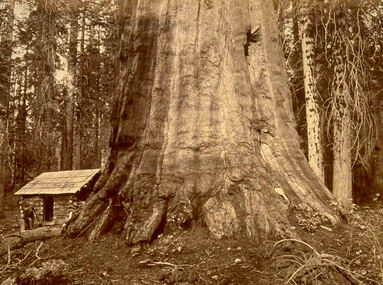
"Wm. H. Seward," Mariposa Grove, c. 1868
Stereoview: E. Muybridge (click to enlarge) |
|

Galen Clark and Giant Grizzly, c. 1865
Stereoview: C. E. Watkins (click to enlarge)
Galen Clark, described by John Muir as "one of the most sincere tree – lovers I ever knew," appears as a rugged frontiersman in many of the early photos of Mariposa Grove; above he stands beside the Grizzly Giant. His cabin at the base of a huge Sequoia became a picturesque icon of homesteading in Yosemite Valley (left). This particular Sequoia, named "Wm. H. Seward," measured 268 ft high and 85 ft in circumference. |
|
| |
|
|
 |
|
| |

Grizzly Giant, c. 1870
Photo by C. E. Watkins |
What a singular assemblage of these age–old patriarchs has nature preserved for us! Still growing, still reproducing yet linking the prehistoric with the present. Could they but speak, what strange tales would be told to the world of storms, of droughts, of earth quakes and all they have withstood; yet they stand erect and defiant.
Here it seems as though one is standing in a great temple, silent, restful, with the air seemingly filled with eternal peace. These huge sentinels stand with their arms out – stretched like that of the Infinite One saying to the troubled world, 'Peace be still.' The hardest heart will be softened when gazing upon these wonderful gifts of God. Herbert Earl Wilson,The Lore and the Lure of the Yosemite, 1922 |
The 1860s mammoth photos of the Mariposa Grove by Carleton E. Watkins were widely acclaimed. These and stereoviews of the big trees helped influence the US Congress to pass protective legislation for the grove. Watkins' photos illustrate the influential 1868 "Yosemite Book" by Josiah Dwight Whitney, state geologist of California. Whitney spoke on behalf of conservationism and he urged the state to make Yosemite Valley a national park. Also in 1868 Eadweard Muybridge published his photos in "Yosemite: Its Wonders and Its Beauties" by John S. Hittell. |
|
As US Secretary of State under Abraham Lincoln, William H. Seward was most famous for his acquisition of Alaska from Russia in 1867. In the Mariposa Grove the practice of naming big trees after powerful white men – politicians, statesmen, military heros and wealthy industrialists – was widespread, although few names have endured.
|
Mariposa Grove of Big Trees (click to enlarge)
Stereoviews by Eadweard Muybridge |
 |
Washington, 272 ft high
92 ft in circumference |
 |
Grant, 250 ft high, 64 ft in circumference |
 |
Ferdinand de Lesseps, 250 ft high, 84 ft in circumference |
 |
Leland Stanford, 268 ft high,
82 ft in circumference |
 |
Col. Thos. A. Scott, 264 ft high, 75 ft in circumference |
|
|
| |
|
|
 |
|
| |
|
|
| |
|
|
 |
|
| |
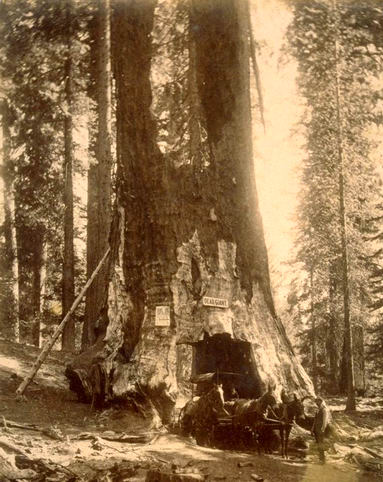
"The Big Tree, Tuolumne Grove, 1877"
Photo: Bancroft Library |
|
The Tuolumne Grove is located in northwestern Yosemite National Park in Tuolumne County, California. Originally the grove was bisected by the Big Oak Flat road which was the stagecoach route into the Yosemite Valley. Tuolumne is the name of the indigenous peoples that lived along the Tuolumne River for thousands of years until they were dispossed of their land by settlers in the 1850s. Today they are recognized by the US Bureau of Indian Affairs as the Tuolumne Band of Me – Wuk Indians of the Tuolumne Rancheria. The Tuolumne Grove is the only stand of big trees in North America to have an indigenous name.
When gold was discovered in the Sierra Nevadas in the mid 19th century, miners and settlers flooded into what became Tuolumne County. Many ancient Sequoias were destroyed as the native forests were logged to provide the mines with timber. A cut down Sequoia that was stripped of her bark is pictured in an early photo (left), entitled "The Big Tree, Tuolumne Grove, 1877 – on the Big Oak Flat Road to Yosemite." Called the "Dead Giant" (see sign), she was the first of the "tunnel trees" created as tourist attractions. |
|
| |
|
|
 |
|
| |
 |
Left: "Big Oak" 36 ft in circumference, c. 1870, Big Oak Flat. The limbs of this ancient oak tree had been cut off by settlers, leaving her massive torso as a dramatic landmark (click to enlarge) |
 |
 |
Left: "Dead Giant" 30 ft, 8 in diameter, c. 1880, Tuolomne Grove, on the Big Oak Flat route to Yosemite Valley. Stereoview: Carleton E. Watkins, New Series (click to enlarge) |
 |
Left: photo by Cliff Stone, 1 July 1962. In 1960 a new road was built from Big Oak Flat and the old road was converted to a scenic drive to the Dead Giant in Tuolomne Grove
Right: "General Lawton," Tuolumne Grove, c. 1880. Named for the Civil War hero who captured Apache Chief Geronimo |
|
|
| |
|
|
|
|
| |

Merced Grove, Yosemite Natonal Park
Photo: D. Goldberg
The English immigrant and placer miner James Hutchings was one of the first settlers in Yosemite Valley and he became an early promoter of the big tree groves as tourist attractions. He believed that the Sequoia gigantea and the Sequoia sempervirens, or redwood of the coast, were the "twin representatives of the finest genus of forest trees yet known to man" and he bitterly forecast that these glorious new wonders of the world were doomed by "business greed and lack of foresight in the government" which was causing them to so rapidly disappear that "within a quarter, or at most a third of a century, they will have been swept from off the earth" In the Heart of the Sierras (1888).
In his 1912 book on Yosemite Valley, the Scottish born naturalist John Muir warned: "Perhaps more than half of all the big trees have been thoughtlessly sold and are now in the hands of speculators and mill men." He proposed the radical idea that all private claims on the big trees should be extinguished by government purchase. |
|
Merced Grove (left) is located not far from the Tuolumne Grove in Yosemite National Park in Mariposa County. It is one of the three giant Sequoia groves protected in the park that were initially guarded from being logged by the calvary troops of the US Secretary of the Interior.

"The Twin Sequoias, Merced Grove"
Old postcard |
|
| |
|
|
 |
|
| |

"Bull Buck Tree," Nelder Grove, 2006
Photo: Aaron |
|
The Nelder Grove (left) is located on a branch of the Fresno River in Madera County, California. In 1893 it became part of the Sierra National Forest. Originally known as the Fresno Grove, it was later named after John A. Nelder, affectionately called the "Hermit of the Fresno Forest" by the naturalist John Muir who often visited him. Nelder Grove contains many stump relics from the lumbering days along with about 100 mature Sequoias. The largest surviving tree in the grove is "Bull Buck," which has a ground level circumference of 99 ft (30 m) and is 246 ft (75 m) high (left). |
|
| |
|
|
|
|
| |

"Cutting Out A Section of the Big Tree," 1865
Lawrence & Houseworth |
|

"Big Tree Felled in Fresno Grove"
Stereoview: J. Soule (click to enlarge)
When the Fresno Grove was discovered by settlers in 1857, it was said to contain about 600 giant Sequoias. One of them was the 79 ft in circumference "Big Tree" (above and right), pictured as sections of it were being cut out. The Nelder Grove was logged extensively by the Madera Flume & Trading Company which flumed the giant Sequoias down the mountain to sawmills in the lumbering town of Madera. |
|
| |
|
|
 |
|
| |
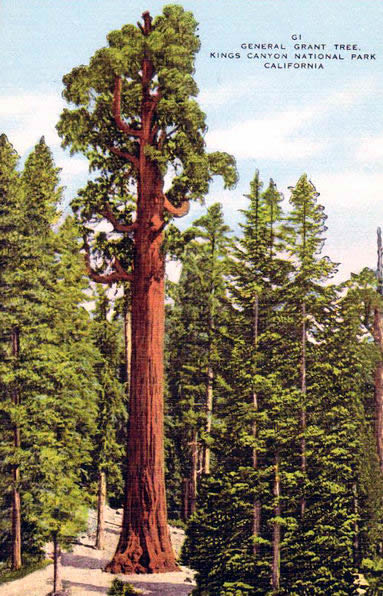
General Grant Tree, King Canyon National Park
Old postcard
On 29 March 1956 President Eisenhower proclaimed the famous General Grant Tree a National Shrine to commemorate American war veterans. Once thought to be 4000 years old in view of its enormous width (right), today General Grant is estimated to be from 1500 to 2000 years old. Also residing in the Grant Grove is another tree named for a Civil War general, "Robert E. Lee," the second largest tree in the grove and the eleventh largest in the world. |
|
Grant Grove is named after its famous inhabititant, the "General Grant Tree" (left).
The grove was protected in 1890 as the four mile square General Grant National Park, and in 1940 it was incorporated in the new Kings Canyon National Park which is today contiguous with Sequoia National Park (located in Fresno and Tulare Counties). The General Grant Sequoia was discovered in 1862 by Joseph Thomas and named in 1867 by Lucretia Baker. It is the largest tree in the Grant Grove and one of the largest in the world, at 264 ft high and 35 feet in diameter, with an estimated volume of 46,608 cubic ft (1,320 cubic m). On 28 April 1926 General Grant was additionally designated by President Coolidge as the "Nation's Christmas Tree" (below).
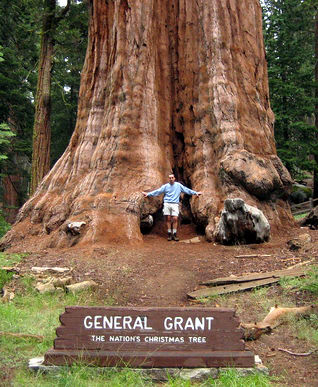
"General Grant," 2006
Photo: Flickr |
|
| |
|
|
 |
|
| |

"Boole Tree," Sequoia National Forest, 2006
Photo: Flickr
The Boole Tree was photographed with a group of loggers at her base by J. W. Bledsoe in 1890 (right). During this period, when the Converse Basin Grove was being ruthlessly logged, John Muir visited and the devastation inspired his resolve to saving the nearby groves of Kings Canyon.

"A California Sequoia Gigantea Log," 1901
Photo: A. R. Moore |
|
The Converse Basin Grove is located in the Sequoia National Forest, established in 1908 by the US Forest Service. The forest, which spans three counties (Tulare, Kern, and Fresno), has been heavily logged. A solitary survivor of the grove is the "Boole Tree" (left). It was left standing in the Sanger Lumber Company's logging camp to pay tribute to the camp supervisor, Frank Boole, for whom it is named. Ironically Boole was responsible for the slaughter all the big tree inhabitants of the surrounding forest. The Boole Tree stands 269 ft tall and has a diameter of 35 ft. It is the largest tree on National Forest System land and one of the largest trees in the world.

Boole Tree and loggers, 1890
Photo: San Joaquin Valley Library
One of the tragic casualties of the Converse Basin Grove can be seen in the 1901 photo (left). This formal group photo is a "trophy" style composition with dozens of loggers demonstrating their mastery over the gigantic prostrate monster, noted in the caption as being 36 ft in diameter. |
|
| |
|
|
 |
|
| |

Muir Grove, Sequoia National Park
Don Bain's Virtual Guidebook |
|
Muir Grove (left) is located in the Sequoia National Park in Tulare County, California, which was established in 1890. The Scottish born naturalist John Muir, for whom the grove is named, believed the Sequoia to be the king of all the conifers in the world, and called it "the noblest of a noble race." Largely due to his engagement, many Sequoia groves in the Sierra Nevadas were saved. |
|
| |
|
|
|
|
| |
|
"And when you stand back far enough to see the massive columns from the swelling instep to the lofty summit dissolving in a dome of verdure, you rejoice in the unrivaled display of combined grandeur and beauty."
"About a hundred feet or more of the trunk is usually branchless, but its massive simplicity is relieved by the bark furrows, which instead of making an irregular network run evenly parallel, like the fluting of an architectural column, and to some extent by tufts of slender sprays that wave lightly in the winds and cast flecks of shade, seeming to have been pinned on here and there for the sake of beauty only."
John Muir,
The Mountains of California, 1894 |

Muir Grove, 2007
Photo: Larry Probst |
Illustrating the words of John Muir is an engraving (right) of an ancient forest scene based on a famous c. 1860 photo by C. E. Watkins: "The giant pines, and firs, and Sequoias hold their arms open to the sunlight, rising above one another on the mountain benches, marshaled in glorious array, giving forth the utmost expression of grandeur and beauty with inexhaustible variety and harmony." |
|
One of the earliest publications by John Muir was his 1878 article "God's First Temples: How Shall We Preserve Our Forests?" Here he used the title of William Cullen Bryant's poem to propose the radical conservationist idea that the federal government take responsibility for the protection of the endangered wilderness landscapes and native forests of California.

"View of the Sierra Forest." Engraving
The Mountains of California, 1894 |
|
| |
|
|
 |
|
| |

"General Grant," Big Tree Grove
Old postcard, 1902 |
|
The Big Tree Grove is today part of the Henry Cowell Redwoods State Park, located near Felton on the San Lorenzo River in Santa Cruz County, California. It was the first coast redwood grove to be saved from logging when it was purchased in 1867 by Joseph Welch for a tourist attraction. By 1900 "Welch's Big Trees Resort" had become a popular stop on the railway from San Jose to the beaches at Santa Cruz and included the Big Tree Station, a hotel, dining hall, cabins and a dance pavilion. Redwoods in the grove were named after Civil War heros such as General Grant (left). |
|
| |
|
|
|
|
| |
American hero General John C. Frémont was said to have camped with his men in the Big Trees Grove, sheltering under a giant redwood that was later named in his honour. A postcard (right) notes its size as 260 ft high and 66 ft in circumference. Frémont is recorded as visiting his namesake in 1888. Three years later President Harrison visited the grove and a group of redwoods was named after him.
|

"Jumbo," Big Tree Grove
|

"The Giant," Big Tree Grove
|
|
|

"General Fremont," Big Tree Grove
Old postcard
Welch's Big Trees Resort was on the itinerary of most tours to the San Francisco area. In 1903 President Theodore Roosevelt visited the Big Tree Grove near Felton. Many of the redwoods had signs on them indicating their names, such as "Jumbo" and "The Giant" (left). The Giant was advertised as the "largest message board in the world" due to the many notices posted on his torso. President Roosevelt expressed his dislike of this practice and it was largely discontinued. |
|
| |
|
|
 |
|
| |

"Big Trees, Felton, Santa Cruz County"
Photo: Bancroft Library
Early photographers like Carleton E. Watkins, Eadweard Muybridge, Isaiah West Taber, and Andrew Putnam Hill were essential to bringing the plight of the ancient big trees to public attention. Hill valiantly battled the lumber industry in the Santa Cruz Mountains and with his Sempervirens Club he succeeded in founding the California Redwood Park in 1902, now Big Basin Redwoods State Park. General Fremont, seen above in a c. 1870 photo, is today still thriving (right). |
|
Even as the redwood giants of Santa Cruz County became ever more popular attractions, with tourist trains from San Jose stopping regularly at the Big Trees Station by Feldon, the destruction by logging companies continued relentlessly. Welch's Big Trees Resort operated until 1930, when Santa Cruz County purchased the property to conserve what was by now a rare old growth grove. An adjacent property that belonged to the settler Henry Cowell was later donated to the State by his family and on 15 August 1954 the Henry Cowell Redwoods State Park was dedicated.

"Fremont," Santa Cruz County, 2007
Photo: Flickr |
|
| |
|
|
 |
|
| |
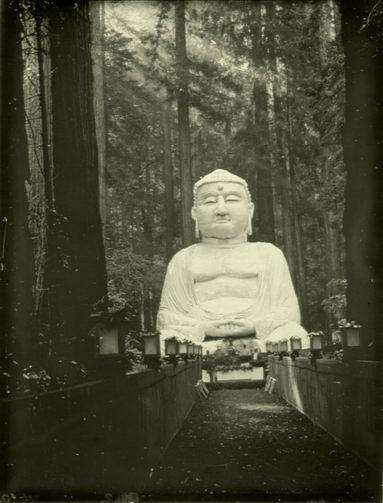
Bohemian Grove, Muir Woods, 1892
Photo: Bancroft Library (W. Oliver) |
|
Bohemian Grove (left) is located in the Muir Woods National Monument north of San Francisco, in Marin County, California. Muir Woods was preserved by President Theodore Roosevelt who signed a presidential proclamation on 9 January 1908 declaring the rare surviving stand of ancient redwood trees to be of "extraordinary scientific interest and importance." Naturalist and Sierra Club founder John Muir, for whom the monument was named, pronounced it as "the best tree lovers monument that could possibly be found in all the forests of the world."
Bohemian Grove was named by the Bohemian Club, a San Francisco men's club founded in 1872, which held occasional encampments in the grove. The 1892 encampment at the Bohemian Grove included a large amphitheatre and a 70 ft statue of Buddha (right). In the 1880s the Bohemian Club began to hold their gatherings in a more remote redwood forest on the Russian River in Sonoma County. In 1893 the club bought the property and it became known as a later "Bohemian Grove." For more on the club's recent controversial commercial logging of this rare example of a surviving ancient forest stand, see:
Save Bohemian Grove. |
|
| |
|
|
|
|
| |
Ironically, Muir Woods was in part saved due to the lobbying of President Roosevelt by Gifford Pinchot, the first chief of the US National Forest Service (1898 – 1910), and an opponent of Muir's preservationist ideals. To honour Gifford, one of the largest redwoods was dedicated to him on 5 May 1910 during a ceremony organized by the Sierra Club (right). A speech was given by William Kent, who had donated the land for the monument. The plaque read "This tree is dedicated to Gifford Pinchot, Friend of the Forest, Conserver of the Common Wealth." Th dedication must have annoyed Muir who had an adversarial relationship with Pinchot. For more on the legendary animosity between the two men, which peaked during the 1913 debate in Congress over a bill to construct a dam in the Hetch Hetchy Valley, see Michael B. Smith:
The Value of a Tree (The Historian, 1998). |
|

Pinchot Tree Dedication, 5 May 1910
Photo: Bancroft Library |
|
| |
|
|
 |
|
| |

Founders Grove, 2008
Photo: Flickr |
|
Founders Grove (left) is located in northern California, in Humboldt Redwoods State Park in Humboldt County. Following the completion of the Redwood Highway (US 101) in 1917, the redwood forests were opened up to logging. To try to stop the rampant devastation, three prominent conservationists (John C. Merriam, University of California paleontologist; Madison Grant, chairman of the New York Zoological Society; and Henry Fairfield Osborn, president of the American Museum of Natural History in New York) launched the movement to protect the forests in 1918. Founders Grove was dedicated to them in 1931. |
|
| |
|
|
 |
|
| |

Dyerville Giant, Founders Grove, 2008
Photo: anon
Humboldt Redwoods State Park is accessed from the Avenue of the Giants, also called Cathedral Aisles (right), a 32 mile scenic alternative to Highway 101. The park covers more than 50,000 acres of which about 17,000 acres are old growth redwoods. Most of the park land was donated to the State of California by the Save – the – Redwoods – League. In 1931 an important purchase was the 10,000 acre Rockefeller Forest from Pacific Lumber Company, made possible by a gift by John D. Rockefeller, Jr.

Bolling Grove, Humboldt Redwoods State Park
Photo: Flickr |
|
Founders Grove is home to the Dyerville Giant, a 500 ton redwood tree that was one Earth's largest creatures. Born a thousand years before Columbus, it stood here for about 1600 years before it fell on 24 March 1991 (left). At the time the Giant was 362 ft high, 17 ft in diameter, 52 ft in circumference and had a crown spread of 74 ft.

Avenue of the Giants, c. 1930
Old postcard
The League inaugurated a memorial grove program in 1921 that has since vastly expanded. The first grove was founded in honor of Colonel Raynal Bolling, the first American Army officer of high rank to fall in World War I. The cathedral like Bolling Grove (left) includes 100 acres of ancient redwoods on the banks of the Eel River. In 1955 an expansion of Highway 101 was planned through the Founders Grove. Members of the League managed to stop the bulldozers and today the four lane freeway skirts the old growth redwoods native to Humboldt County, the largest contiguous intact redwood forest in the world. |
|
| |
|
|
 |
|
| |

Grove of Patriarchs, Rainier National National Park
Photo: Flickr
"Let us be reverent a little as we stand here in the hush of these leafy sanctuaries - be reverent a little, if reverence in this age is possible. These great trees belong to the silences and millenniums. Many of them have seen more than a hundred of our human generations rise, and give out their little clamors and perish. They chide our pettiness, they rebuke our impiety. They seem, indeed, to be forms of immortality standing here among the transitory shapes of time" Edwin Markham, California the Wonderful, 1914. |
|
The Grove of the Patriarchs (left) is located in Mount Rainier National Park in Washington State, which was established in 1899. Clustered on a small island in the Ohanapecosh River, some of the oldest big trees are more than 30 ft in circumference and have survived fires and floods for a thousand years. Most of the grand native forests in the Mount Rainier area have been destroyed. Mount Rainier Forest Reserve was established in 1897 but it became part of a land grab by the Northern Pacific Railroad. Sold off to timber and mining companies, the forests were clearcut logged, strip mined, developed, paved and degraded into checkerboard landscapes.

Grove of Patriarchs, Rainier National Park
Photo: D. Loon |
|
| |
|
|
 |
|
| |
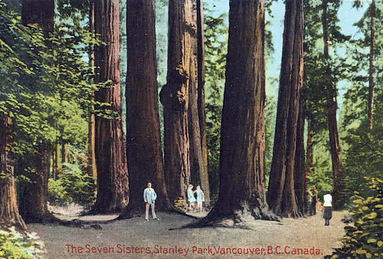
"Seven Sisters," Stanley Park, Vancouver BC
Old postcard, c. 1930 |
|
Seven Sisters Grove was located in Stanley Park, Vancouver, BC. It was needlessly destroyed by city officials in 1967. Indigenous author E. Pauline Johnson described the Grove in 1913: "There is a well known trail in Stanley Park that leads to what I always love to call the Cathedral Trees – that group of some half dozen forest giants [above] that arch overhead with such superb loftiness. But in all the world there is no cathedral whose marble or onyx columns can vie with those straight, clean, brown tree boles that teem with the sap and blood of life"
Lure in Stanley Park. |
|
| |
|
|
|
|
| |

Randy Stoltmann Grove, Carmanah Walbran Park
Vancouver Island, British Columbia |
|
The Randy Stoltmann Grove (left) is located in the Carmanah Walbran Provincial Park on Vancouver Island in BC. It was protected only after a dedicated environmental battle initiated by Randy Stoltmann in 1988. It is shocking that the ancient rainforest outside the park boundaries, the Upper Walbran, continues to be clearcut logged today. The grove was named in tribute to Stoltmann who died at a young age while mountain climbing. He wrote: "Hear the roaring wilderness of a great valley, Or the sigh of the wind in the tree tops, Or the eternal thunder of breakers on the shore. Then go back and speak to the world from your heart." |
|
| |
|
|
 |
|
| |

Endangered Koksilah Grove, 2007
Photo: Warrick Whitehead |
|
The unprotected Koksilah Grove (left) is located north of Victoria, Vancouver Island, BC, on private forestland which is the traditional territory of the Koksilah Cowichan Tribe. The ancient inhabitants of the grove included the largest and tallest Douglas firs in the recorded history of BC yet during the past few decades many have been destroyed by the logging industry. It is shocking that the rare and irreplaceable Koksilah Grove is part of a "tree farm licence," owned by MacMillan Bloedel until 1999, then by the American forest destruction corp Weyerhaeuser. In 2004 it was sold to TimberWest, another cut and run company that is threatening to kill the big tree survivors. |
|
| |
|
|
 |
|
| |
|
|
| |
©
Credits & Contact |
|
| |
|
|
|
|
|

